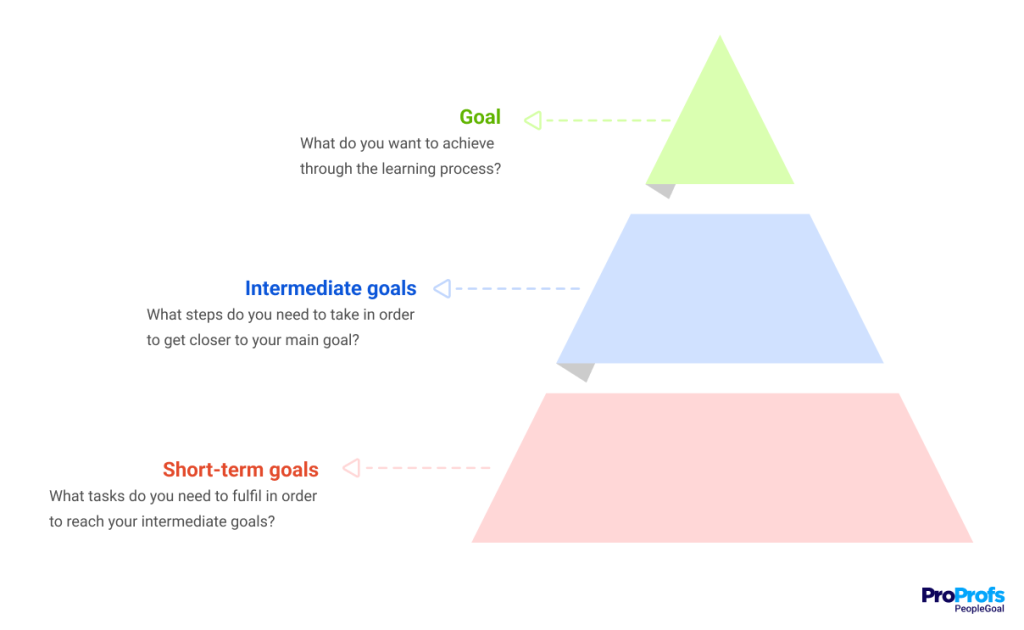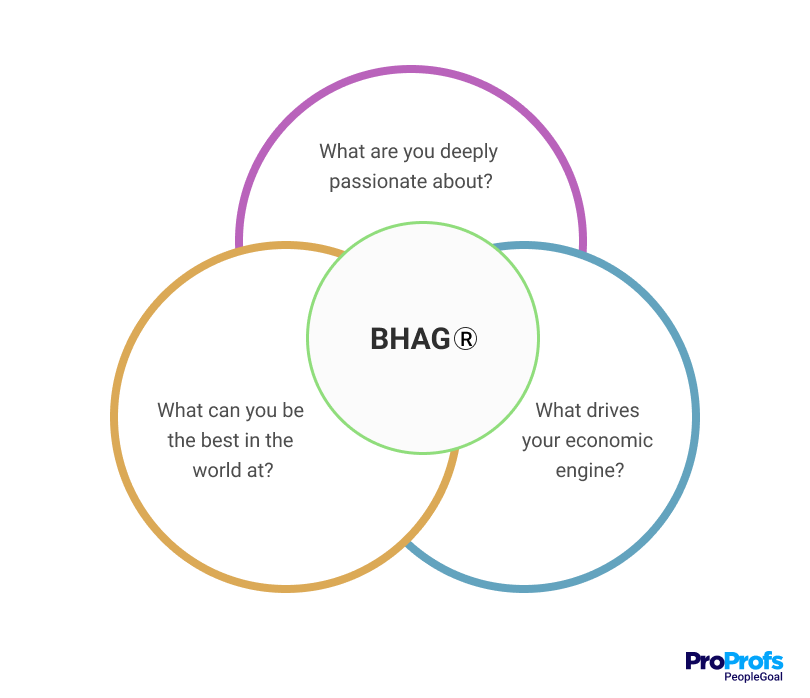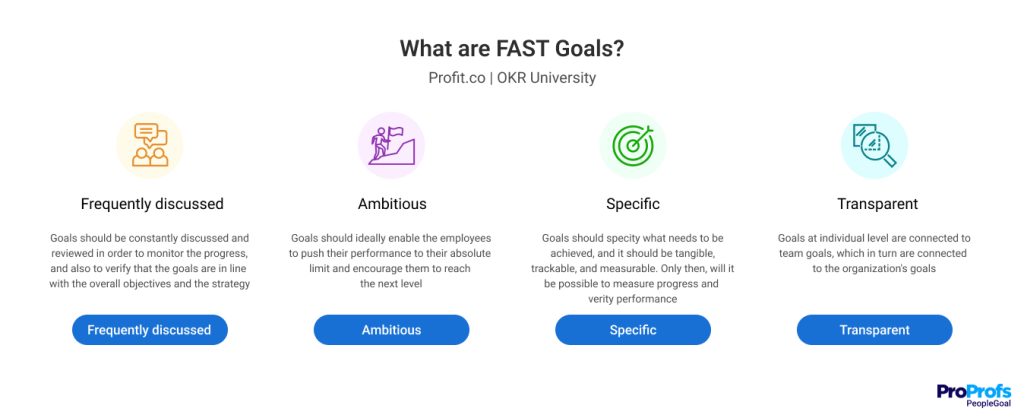Let’s talk about something every leader faces, but few get right: setting performance goals that actually move the needle.
The fastest way to lose your edge? Set goals that don’t drive results.
Here’s the truth—goals aren’t the problem. Bad goals are. The kind that are vague, unrealistic, or completely misaligned with what your team needs to succeed. And when that happens? Motivation dips, productivity stalls, and results suffer.
If your performance management goals aren’t driving real results, they’re holding your team back. But the right goals? They fuel momentum, drive real impact, and create a culture where people thrive.
I’ve seen firsthand how shifting the way you set goals can transform team performance. In this guide, I’ll break down performance management goal examples that actually work, along with the strategies top teams use to stay focused and deliver results.
Let’s dive in.
Why Performance Management Goals Matter
Setting the right performance management goals isn’t just about ticking off tasks—it’s about driving meaningful progress for both employees and the organization. The right performance management goals are clear, well-structured and they ensure employees stay motivated, engaged, and aligned with business objectives.
But why do they matter so much? Let’s break it down.
Providing Clarity and Direction
Without well-defined goals, employees may feel uncertain about priorities and expectations. Clear goals eliminate ambiguity and help individuals focus on what truly matters. When employees know what they’re working toward, they can make better decisions and contribute more effectively.
Effective Approach: A sales team is given a goal to increase monthly revenue by 15%. With clear targets and defined action steps, each member understands their role in achieving the objective.
Ineffective Approach: A sales manager tells the team to “sell more” without specifying a target or strategy. Employees are unsure what success looks like or how to prioritize their efforts.
Enhancing Motivation and Engagement
Employees are more engaged when their work has a purpose. Performance management goals help individuals see the impact of their efforts, increasing job satisfaction and motivation. When employees achieve milestones, it reinforces their sense of accomplishment and encourages continuous growth.
Effective Approach: An HR team introduces an employee development initiative where team members set personal learning goals. Employees who complete courses and gain new skills feel more invested in their roles.
Ineffective Approach: An HR team expects employees to “develop professionally” but provides no resources or incentives. Employees lack the direction and motivation to improve their skills.
Facilitating Performance Tracking
Without measurable goals, it’s difficult to assess progress. Work performance goals examples provide benchmarks for success, allowing both employees and managers to track improvements, identify challenges, and adjust strategies as needed.
Effective Approach: A marketing team aims to increase website traffic by 20% in six months. By analyzing metrics monthly, they refine their approach and stay on course to reach their target.
Ineffective Approach: A marketing team wants to “improve online presence” but doesn’t set measurable KPIs. Without benchmarks, they have no way to assess success or adjust their strategy.
Promoting Skill Development
Goals should not only focus on business outcomes but also on employee growth and professional development. Setting skill-based performance goals and objectives ensures employees continue to improve their capabilities, making them more valuable to the organization.
Effective Approach: A software developer sets a goal to learn a new programming language within a quarter. They enroll in training, practice with real projects, and eventually contribute to a major software update.
Ineffective Approach: A developer decides to “get better at coding” but doesn’t specify what skills to improve or set a timeline. Their progress is inconsistent, and they lack a clear learning path.
Ensuring Organizational Alignment
For a company to succeed, individual performance goals must align with broader business objectives. Goals create a direct link between employee contributions and the organization’s success, ensuring that everyone is working toward a shared vision.
Effective Approach: A retail company focuses on improving customer experience. Store managers set team goals to reduce checkout wait times and enhance customer service, supporting the company’s mission of delivering exceptional service.
Ineffective Approach: A retail company wants to boost customer satisfaction but doesn’t communicate this goal to employees. Without direction, employees continue their usual routines without improving service.
Establishing Accountability
Performance goals encourage employees to take ownership of their work. They set clear expectations for responsibilities and outcomes, helping managers and employees track performance objectively.
Effective Approach: A project manager assigns specific goals to each team member, ensuring accountability and preventing last-minute delays. Each person knows their role and is responsible for meeting deadlines.
Ineffective Approach: A project manager sets a broad goal to “finish the project on time” without assigning tasks. Team members assume others will handle key responsibilities, leading to missed deadlines.
Encouraging Employee Recognition and Rewards
Employees perform better when they know their efforts are valued. Performance goals make it easier to identify high achievers, enabling companies to offer recognition, promotions, or other incentives.
Effective Approach: A company introduces a recognition program for employees who consistently exceed their performance goals. This not only rewards top performers but also inspires others to improve.
Ineffective Approach: A company says it values high performers but offers no structured recognition or rewards. Employees feel their efforts go unnoticed, leading to decreased motivation.
Boosting Productivity and Efficiency
Well-structured goals help employees prioritize tasks, reduce inefficiencies, and focus on impactful work. They create a system where employees spend their time on high-value activities instead of getting lost in unstructured tasks.
Good Example: A product development team aims to reduce production cycle time by 20%. By identifying inefficiencies and optimizing workflows, they increase output while maintaining quality standards.
Ineffective Approach: A team is told to “work faster” without specific strategies or efficiency improvements. Employees rush tasks, leading to lower-quality output and potential errors.
Setting the right performance management goals examples provides employees with clarity, encourages professional development, and ensures that individual efforts align with company objectives. When implemented effectively, they transform the workplace into an environment where employees thrive, and businesses achieve sustainable success.
Employee Performance Goal Examples at Work
Setting clear and actionable performance goals ensures employees know exactly what they need to achieve while also aligning their efforts with business success.
Below are detailed employee goal examples with real-world scenarios to help employees, teams, and leaders create impactful and measurable objectives.
1. Individual Performance Goal Examples
Individual performance goals focus on an employee’s personal contributions to their role. These goals help define success, improve efficiency, and ensure accountability.
Employee goals example and Scenarios:
- Improve time management by reducing time spent on non-essential tasks by 20%.
Scenario: A marketing specialist notices they spend too much time on emails. By implementing time-blocking techniques, they set fixed hours for checking emails and free up time for high-priority projects. - Increase customer satisfaction ratings by 10% over the next six months.
Scenario: A customer service representative commits to active listening, resolving complaints faster, and following up with customers, leading to better service ratings.
2. Team Performance Goals and Objectives Examples
Team goals ensure collaboration and efficiency in a group setting. They help team members work toward a common objective, enhancing overall productivity.
Examples:
- Enhance team collaboration by ensuring at least two cross-departmental meetings per quarter.
Scenario: A product development team schedules regular strategy meetings with marketing and sales to align efforts and improve product launches. - Reduce project turnaround time by 15% by streamlining workflow processes.
Scenario: A software team implements agile methodologies and sprint planning, reducing delays while maintaining quality.
3. Soft Skills Performance Goal Examples
Soft skills such as communication, problem-solving, and adaptability are crucial for career advancement and effective teamwork.
Examples:
- Develop conflict resolution skills by successfully mediating at least one workplace disagreement per quarter.
Scenario: A team lead practices active listening and negotiation techniques, helping resolve disputes efficiently. - Improve public speaking by delivering one team presentation per month.
Scenario: A junior manager participates in internal training sessions and public speaking workshops, gradually building confidence.
4. Accountability in Performance Goal Examples
These goals ensure employees take responsibility for their work and follow through on commitments.
- Track and complete 100% of assigned tasks within set deadlines.
Scenario: A project coordinator uses task management software to set reminders and track deadlines, ensuring tasks are completed on time. - Own up to mistakes and implement corrective actions within 24 hours.
Scenario: A financial analyst makes an incorrect budget forecast. They acknowledge the mistake, revise projections, and document lessons learned to prevent recurrence.
5. Professional Growth Performance Goal Examples
These goals help employees develop new skills and advance their careers.
- Earn an industry certification within the next six months.
Scenario: A data analyst enrolls in a Google Data Analytics course, dedicating time each week to complete training and pass the exam. - Build a professional network by attending at least two industry events per year.
Scenario: A senior HR specialist joins LinkedIn groups, participates in webinars, and attends HR summits to stay updated on industry trends.
6. Collaboration Performance Goals Examples
Collaboration goals focus on improving teamwork and knowledge sharing.
- Host at least one knowledge-sharing session per quarter.
Scenario: A senior software engineer organizes monthly coding workshops, helping junior developers enhance their skills. - Increase interdepartmental collaboration by participating in at least one cross-functional project per year.
Scenario: A sales manager works with the product team to incorporate customer feedback into new product updates, improving overall satisfaction.
7. Problem-Solving Performance Goal Examples
These goals encourage employees to proactively address challenges and enhance efficiency.
- Identify and resolve one recurring workflow bottleneck by the end of the quarter.
Scenario: A logistics coordinator notices frequent shipping delays and redesigns the supply chain process, reducing delivery times by 20%. - Improve decision-making speed by reducing the time taken to resolve customer issues by 30%.
Scenario: A retail manager implements real-time tracking of customer complaints, ensuring issues are resolved within 24 hours.
8. New Employees’ Performance Goal Examples
These goals help new hires integrate smoothly into their roles and the company culture.
- Achieve full proficiency in job responsibilities within 90 days.
Scenario: A new software developer follows structured onboarding and mentorship, reaching full productivity within three months. - Learn company culture and processes by meeting with at least five different departments in the first three months.
Scenario: A new HR manager schedules introductory meetings with key stakeholders to understand company values and expectations.
9. Executive & Leadership Performance Goal Examples
These goals focus on strategic growth, leadership development, and company-wide impact.
- Increase company revenue by 10% in the next fiscal year.
Scenario: A VP of Sales redesigns pricing models, expands into new markets, and optimizes sales strategies, leading to revenue growth. - Improve employee engagement by implementing a structured feedback system.
Scenario: A CEO introduces monthly pulse surveys to gather employee insights, leading to higher retention and satisfaction.
Bonus: To make your survey even more comprehensive, consider adding these bonus questions for deeper insights into employee engagement. DOWNLOAD NOW.
10. Human Resources Performance Goal Examples
HR goals focus on improving recruitment, retention, and employee well-being.
Examples:
- Reduce employee turnover by 15% through career development programs.
Example: An HR director launches mentorship initiatives and leadership training, leading to higher retention. - Shorten hiring timelines by optimizing the recruitment process.
Example: A recruiter implements AI-based resume screening and structured interview formats, reducing hiring time by 30%.
For ongoing discussions, insights, and best practices on performance management, join our Slack community PeopleHeRoes. Connect with like-minded peers, share ideas, and get support on all things People Ops—powered by the team at PeopleGoal.

Performance goals are more than just targets—they shape career development, drive engagement, and enhance productivity. By setting clear, measurable goals, employees can track progress, improve collaboration, and align their efforts with business success. Whether focusing on individual performance, leadership, or skill development, structured goals ensure that employees grow while contributing meaningfully to the organization.
Goal-Setting Methodologies for Performance Management
Setting the right goals is the foundation of effective performance management. But not all goals are created equal. Using structured goal-setting methodologies ensures clarity, motivation, and measurable progress. Whether you’re looking for employee performance goals or high-level strategic objectives, these frameworks provide a roadmap for success.
Let’s explore some of the most impactful approaches to work performance goals and how they can drive success.
1. SMART Goals – The Gold Standard for Goal-Setting
SMART stands for Specific, Measurable, Achievable, Relevant, and Time-bound. This widely used framework ensures that goals are clear, realistic, and trackable.
Example: Increase monthly sales by 15% over the next six months by improving customer follow-ups and offering personalized discounts.
- Specific: Focuses on sales increase.
- Measurable: 15% growth is quantifiable.
- Achievable: Aligns with past performance and current strategies.
- Relevant: Directly impacts business revenue.
- Time-bound: Has a clear six-month deadline.
Why it works: SMART goals help employees stay focused and measure their progress effectively.
Check out this quick video to learn more about setting up SMART goals.
SMART goals ensure clarity by breaking objectives into specific, measurable, and time-bound targets. This method is useful when you need well-structured, achievable goals that help employees stay focused and track their progress effectively.
How to set a SMART goal:
- Specific: Define exactly what you want to achieve.
- Measurable: Identify how progress will be tracked.
- Achievable: Ensure the goal is realistic given resources and constraints.
- Relevant: Align it with broader business objectives.
- Time-bound: Set a clear deadline for completion.
SMART goals are particularly useful for structuring performance goals and objectives examples that align individual efforts with business priorities.
2. OKRs – Driving Business and Individual Performance
Objectives and Key Results (OKRs) focus on setting ambitious objectives and measurable key results. Focus on setting ambitious objectives and measurable key results. Companies like Google use this method to align employee goals with business priorities.
Example: A product manager’s OKR:
Objective: Enhance the mobile app experience for users.
- Key Result 1: Increase app downloads by 25% in Q3.
- Key Result 2: Reduce customer churn rate from 10% to 7% in six months.
- Key Result 3: Improve app store rating from 4.2 to 4.5 stars.
You can use the following OKR Template to measure the goals:
- Objective: What’s the ambitious goal? (e.g., Improve mobile app experience for users.)
- Key Result 1: A specific, measurable milestone. (e.g., Increase app downloads by 25% in Q3.)
- Key Result 2: Another quantifiable metric. (e.g., Reduce customer churn rate from 10% to 7% in six months.)
- Key Result 3: Final success indicator. (e.g., Improve app store rating from 4.2 to 4.5 stars.)
Why it works: OKRs push for ambitious yet measurable progress, fostering innovation and accountability.

(Image Source: UTSA Performance Management Rating Guide)
3. Locke and Latham’s 5 Principles – The Psychology of Goal-Setting
This goal-setting approach is backed by psychology, ensuring employees stay engaged and motivated. It emphasizes clarity, challenge, commitment, feedback, and task complexity to maximize success.
Example: A new HR leader wants to improve employee retention.
“Reduce turnover from 18% to 12% in one year by launching mentorship programs, leadership training, and quarterly employee engagement surveys.”
Before setting a goal, ask yourself:
- Is the goal clear and well-defined?
- Does it present a challenging yet realistic target?
- Have I ensured commitment from key stakeholders?
- Is there a feedback mechanism to adjust strategies?
- Can complex goals be broken into manageable steps?
Why it works: These principles ensure that goals are engaging, structured, and adaptable.

4. Goal Pyramid – Aligning Individual, Team, and Organizational Goals
The Goal Pyramid ensures that every employee’s efforts contribute to the company’s broader vision. It structures goals at three levels: Visionary Goals (Long-term), which represent the company’s overarching mission; Strategic Goals (Mid-term), which are Departmental objectives that support the mission; and Operational Goals (Short-term), which are Individual tasks that contribute to team success.
Example: A company wants to expand internationally.
- Visionary Goal: Enter five new markets within three years.
- Strategic Goal: Increase international partnerships by 30% this year.
- Operational Goal: Each salesperson must onboard five new international clients per quarter.
Why it works: The Goal Pyramid ensures alignment between company vision and individual efforts.
Goal Mapping Worksheet:
- Visionary Goal (Long-term): What is the ultimate company mission?
- Strategic Goal (Mid-term): How do departments contribute to this mission?
- Operational Goal (Short-term): What individual actions support the strategy?

5. BHAG – Thinking Big with Bold Goals
Big Hairy Audacious Goals (BHAGs) are bold, long-term goals that inspire innovation and massive progress.
Example: Tesla’s BHAG:
“Accelerate the world’s transition to sustainable energy.”
In a corporate setting:
- A tech company could set a BHAG to reach one billion users in 10 years.
- A personal BHAG could be “Become a global thought leader in AI research within 15 years.”
Why it works: BHAGs create long-term motivation and push teams to think beyond limitations.
How to create a BHAG:
- Identify a 10+ year vision that excites your team.
- Ensure it is bold but achievable with sustained effort.
- Align it with industry trends and future opportunities.
- Inspire commitment by connecting it to a bigger purpose.

6. FAST Goals – A Modern Alternative to SMART
Unlike SMART goals, which focus on realism, FAST (Frequent, Ambitious, Specific, Transparent) goals encourage adaptability and continuous progress.
- Frequent: Goals are reviewed regularly, not just annually.
- Ambitious: Encourages stretch goals beyond comfort zones.
- Specific: Clearly defined actions and results.
- Transparent: Goals are openly shared across teams.
Example: A customer success team sets a FAST goal:
“Reduce customer support ticket resolution time by 40% in three months by automating FAQs and AI chatbots.”
Why it works: FAST goals foster continuous improvement and quick decision-making.
How to implement FAST goals:
- Frequent: Review and adjust goals regularly.
- Ambitious: Encourage stretch goals beyond comfort zones.
- Specific: Clearly define actions and measurable results.
- Transparent: Share goals across teams for accountability.

Choosing the right goal-setting methodology depends on your company’s needs, culture, and ambition level. Whether using SMART goals for clarity, OKRs for alignment, BHAGs for bold vision, or FAST for agility, the key is to set goals that inspire action and measurable progress.
Case Study 1:
How Sandvine Made Goal-Setting Work for Everyone
The Challenge: Lack of Goal Alignment
Setting goals is one thing—making them meaningful and achievable is another. Sandvine, a global leader in network intelligence, struggled to ensure that every employee’s goals aligned with the company’s overall vision. Without a structured approach, employees felt disconnected from larger business objectives, leading to misaligned priorities and inconsistent performance tracking.
The Solution: Implementing PeopleGoal’s SMART Goals Module
To bridge the gap, Sandvine adopted PeopleGoal’s SMART Goals module, a structured, easy-to-use goal-setting framework that transformed how employees and managers approached performance goals.
This solution enabled them to:
- Simplify Goal Management – Employees and managers could set, track, and measure progress effortlessly.
- Align Individual Goals with Company Objectives – Every goal contributed to broader business priorities, ensuring that employees’ efforts directly impacted company success.
- Boost Engagement and Accountability – Employees became more invested in their work, understanding the direct value of their contributions.
The Impact: A Culture of Goal-Setting and Achievement
The transformation was remarkable. Sandvine saw a 5x increase in employees setting and achieving goals, leading to more focused and motivated teams. Today, they set over 2,500 individual goals annually, creating a high-performance culture where employees thrive.
“It’s made a real difference having the personalized training calls and guides, and having the responsive support team handy via chat is great for both employees and admins.” – Amanda Lavallee,HR Systems Analyst – Amanda Lavallee,HR Systems Analyst |
Key Takeaways from Sandvine’s Success:
- Use structured goal-setting tools to simplify management and tracking.
- Align every individual’s goals with the company’s broader objectives to drive employee engagement.
- Support employees with training and real-time feedback to reinforce goal achievement.
Sandvine’s success story proves that with the right tools and approach, goal-setting can go beyond a routine task—it can drive real business results.
Case Study 2:
How Blue Origin and SpaceX Use Goal-Setting to Achieve the Impossible
The Challenge: Turning Ambitious Space Dreams into Reality
Space travel was once limited to government agencies with massive budgets and extensive resources. But Blue Origin (founded by Jeff Bezos) and SpaceX (founded by Elon Musk) set out to disrupt the industry. Their goal? Make space exploration and tourism accessible to everyday people.
However, breaking into the space industry required:
- Clear long-term vision with achievable short-term goals.
- A structured goal-setting methodology to measure progress.
- A way to align teams toward innovation while managing risk.
The Solution: Strategic Goal-Setting for Long-Term Success
Both companies relied on structured goal-setting methodologies to transform their vision into reality:
Breaking Down Big Goals into Smaller Milestones – Instead of focusing only on long-term aspirations (like Mars colonization), they created incremental milestones to ensure continuous progress.
Using OKRs for Measurable Progress – Blue Origin and SpaceX used Objectives and Key Results (OKRs) to track success in key areas like launch performance, safety, and reusability.
Incremental Innovation – SpaceX started with small-scale rocket launches, learning from each attempt before advancing to larger, groundbreaking missions like the Falcon 9 reusable rocket and the Starship program.

The Impact: Achieving Unprecedented Milestones in Space Travel
By following a structured approach to goal-setting, both companies have achieved historic milestones:
- Blue Origin successfully launched commercial suborbital flights and plans to land on the Moon by 2024.
- SpaceX became the first private company to send astronauts to the International Space Station and secured multi-billion-dollar NASA contracts.
Key Takeaways from SpaceX and Blue Origin:
- Break down big, audacious goals into smaller, achievable steps.
- Use OKRs to track key milestones and ensure measurable progress.
- Embrace continuous learning and innovation to improve with every iteration.
These companies prove that structured goal-setting is the key to turning ambitious dreams into reality—whether in space exploration or any other industry.
Turn Your Goals into Achievements
Setting effective performance management goals isn’t just about improving individual performance—it’s about creating a culture of continuous growth. Clear, well-structured employee performance goals examples help organizations track progress, enhance accountability, and align personal achievements with business success.
Whether using SMART goals, OKRs, or other goal-setting methodologies, companies that prioritize structured performance management see higher engagement and productivity. When goals are well-defined and progress is regularly tracked, success becomes not just possible—but inevitable. The key is to make goal-setting an ongoing, strategic process that drives measurable success.
You can use tools like PeopleGoal to eliminate the guesswork of performance management. It helps you set clear, structured goals using frameworks like SMART Goals and OKRs, ensuring every employee’s efforts align with your company’s big-picture success.
With real-time tracking and automated reporting, you’ll always know where your team stands. Best of all? PeopleGoal is built to fit your business, whether you’re scaling fast or refining your current processes. With a fully customizable platform and seamless integrations, driving performance has never been easier.
Learn More :
1. What are the 5 SMART goals examples for employees?
Here are five SMART goal examples for employees:
- Increase productivity by 15% in three months using time management techniques.
- Enhance communication by attending a workshop and applying skills in meetings.
- Boost sales by 10% in six months through better customer engagement.
- Develop leadership by mentoring two juniors in a quarter.
- Expand technical skills by earning a certification in six months.
2. What is an example of a SMART performance goal?
A SMART performance management goal example is: “Increase customer satisfaction scores by 10% within six months by implementing a new feedback system and resolving complaints within 24 hours.” This goal is Specific (improving customer satisfaction), Measurable (10% increase), Achievable (through a feedback system), Relevant (enhances customer experience), and Time-bound (six months).
3. What are some common challenges in setting effective performance goals?
Common challenges in setting performance management goals include lack of clarity, making goals vague or unrealistic; misalignment with organizational objectives, causing confusion; inadequate resources or support, leading to frustration; lack of measurable criteria, making progress hard to track; and poor follow-up, reducing motivation and accountability in the performance management process.
Ready to 3x Your Teams' Performance?
Use the best performance management software to align goals, track progress, and boost employee engagement.



![What Is EPM Software? [Detailed Guide + Best Tools]](https://www.peoplegoal.com/blog/wp-content/uploads/2025/03/New_enterprise-performance-management-software.png)

